Site maintainance
This site is a fairly standard GitHub Pages setup using Jekyll. Documents are served from the osl-docs repository. Most of the extras like page lists and navigation sections are handled automatically. Here are some of the common tasks
Writing pages
Making a new page
Make a new file anywhere - but best to put it in the docs folder. Start the file with
---
layout: default
title: MyTitle
resource: true
categories: documentation
---
The document will automatically be added to the navbar section corresponding to its category, and the title will also be placed at the top of the page content. After this header, write content in Markdown (the same as on GitHub wiki pages).
Adding a table of contents
Put
* TOC
{:toc}
at the top of the page
Adding an image
{:style="max-height: 400px;"}
Linking to a file
[session3_ohba_workshop_osl_source_recon_2017.pdf](/osl-docs/downloads/- session3_ohba_workshop_osl_source_recon_2017.pdf)
Linking to another wiki page
[Link](/osl-docs/Home)
[a relative link](another-page.md)
Linking to a section within the wiki
If the section has a title (e.g. with a series of hashes) then you can refer to it as
### My Section
See [here](#another-section)
### Another section
where spaces are swapped for hyphens and everything is lowercase.
Linking to a Matlab tutorial
[link](/osl-docs/matlab/osl_example_oslview.html)
Writing tutorials
Making a new tutorial
- Write the content in Matlab
- Run
osl_publishon your Matlab file - Add and commit the files in the
osl-docsrepository (NOTosl-core)
Renaming a tutorial
One thing that osl_publish does instead of just publish is that automatically adds the requisite YAML header to the resulting HTML file so that it is included when the site is built by Jekyll. All of the published tutorials start with something like
---
layout: matlab_wrapper
title: OAT 3 - Sourcespace Analysis
resource: true
categories: examples
---
The title or category could be manually changed, if designed. However, so that the tutorials can be rebuilt when required, is is highly advised to edit the tutorial script and to re-publish it, rather than making manual changes to the pages.
Managing the site
Making a new nav section
Open _config.yml. There is a list of categories e.g.
category-list: [overview,examples,documentation,archive]
Add your category to the list. It will appear in the navbar and any pages given that category will automatically be added to it
Making a link to a page in the navbar
If you just want to link to a page in the navbar, edit _includes/navigation.html. There is a list that corresponds to the content of the navbar. Currently, the first item in the list is a link to the home page e.g.
<li><a href="/osl-docs/"">Home</a></li>
Add other links in the same way. Put them before or after the automatically generated set of dropdowns.
Running the site locally
When developing the tutorial pages, it can be helpful to view the pages locally. After checking out a copy of osl-docs, first make sure you have all the dependencies
gem install bundler
brew install libxml2 libxslt
sudo gem install nokogiri -v 1.6.8.1 -- --use-system-libraries=true --with-xml2-include=/Applications/Xcode.app/Contents/Developer/Platforms/MacOSX.platform/Developer/SDKs/MacOSX10.12.sdk/usr/include/libxml2
Then install the GitHub jekyll dependencies
bundle install
Finally, run the local server
./local_server.sh